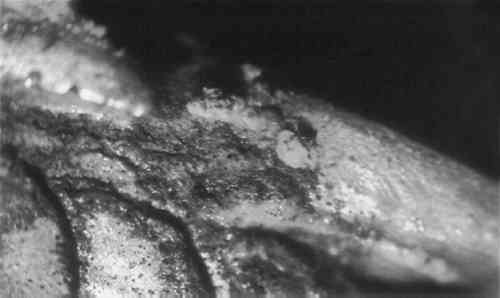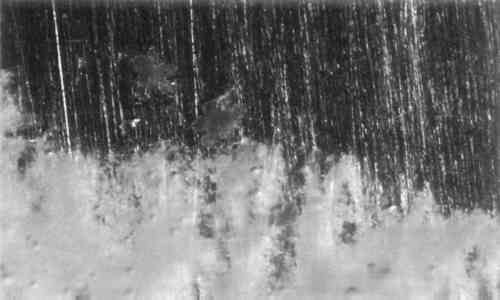TREATMENT OF A SILVER DRAGON FOR THE REMOVAL OF SILVER CYANIDE AND CHALCONATRONITEDonna K. Strahan
6 TREATMENT OF THE SILVER DRAGONTHE PURPOSE OF THE TREATMENT was to remove both the silver cyanide and the chalconatronite corrosion products. The two corrosion products were removed in separate stages. The treatment was begun by removing the old coating with organic solvents. Some of the silver cyanide was removed at this time but some of it remained
Silver cyanide is readily soluble in ammonium hydroxide (NH4OH), sodium thiosulfate (Na2S2O3), potassium ferricyanide (K3Fe(CN)6) and other alkaline cyanide solutions.14 All of these reagents are capable of harming the sterling silver alloy. Copper is attacked by ammonium hydroxide, and silver by sodium thiosulfate and the alkaline cyanide solutions. Tests were carried out to determine which product would be effective yet damage the alloy the least by varying the concentration and time of contact. A sterling silver blank (7.5% copper) was prepared for metallographic analysis and etched with a mixture of 5 ml concentrated ammonium hydroxide, 10 ml hydrogen peroxide (3%) and 10 ml distilled water, to determine its structure before the test solutions were applied. In this manner the structure of the blank was known and any dissolution by the test solutions could be monitored. The blank was repeatedly polished down roughly half a millimeter and swabbed with test solutions for a specific period of time to discover what reactions, if any, had occurred. High concentrations of all these reagents harmed the alloy. Those solutions which had caused minimal damage were chosen to test the solubility of silver cyanide (see Table). Due to the limited amount of silver cyanide available for testing on the dragon, the accuracy of the tests can not be assured, but from the test results the least damaging and fastest acting solution was selected: aqueous 20% sodium thiosulfate. Table Tests for the Removal of Silver Cyanide Originally, the masking of uncorroded silver areas on the dragon with a resin was planned to prevent the possibility of etching. However, in the limited time available for the treatment no satisfactory coating material was found. Extreme care was taken to keep the cleaning reagent away from the uncorroded surface. The dragon was treated locally, not allowing the sodium thiosulfate solution to remain on the surface for more than 30 to 45 seconds. No etching of the surrounding uncorroded metal surface was visible under low magnification, and all of the silver cyanide was removed. It is noteworthy that the underlying metal was found to have been etched during the corrosion process. The sodium thiosulfate solution did not appear to affect the chalconatronite. Where this corrosion product was disfiguring and accessible, it was removed mechanically. Slight pitting in the surface became visible when the corrosion was removed. After thorough rinsing with distilled water and drying, the object was coated with 10% Acryloid B-72 solution, dissolved in 50% methyl ethyl ketone, 40% toluene, 10% diacetone alcohol. The coating was sequentially brushed and sprayed on the object.
|


